Investigating the Effect of Rock Bridge on the Stability of Locked Section Slopes by the Direct Shear Test and Acoustic Emission Technique
Abstract
:1. Introduction
2. Experimental Approach
2.1. Specimen Preparation
2.2. Testing Schemes
2.3. Testing Procedures
- (1).
- Test preparation: turn on the direct shear test instrument for preheating for about 5 min, turn on the computer for system inspection, and start the hydraulic device when all indicators are normal.
- (2).
- AE instrument debugging: connect the cable, amplifier and AE sensors of the AE instrument, turn on the AE instrument and the computer, set the AE signal acquisition threshold voltage to 100 mV, and the sampling frequency to 3 MHz, and use the lead-off method to confirm whether the AE instrument is normal. After debugging, turn off the AE instrument.
- (3).
- Place the specimen: place the specimen in the fixture as required to ensure that the upper and lower clamps are aligned. After the specimen is placed, the loading plate is laid on the upper part of the specimen.
- (4).
- Install the displacement sensor: install the displacement sensor in the vertical direction and the horizontal direction according to the requirements, and adjust the displacement sensor to the appropriate position according to the instructions of the main control computer. In order to ensure the accuracy of displacement, two displacement sensors are installed in vertical direction and horizontal direction, respectively, and the displacement accuracy of the sensor is 0.001.
- (5).
- Installation of AE sensor: apply appropriate an amount of Vaseline between the specimen and AE sensor, and stick the AE sensor onto the surface of the specimen. The specific location of AE sensors is shown in Figure 8. In order to prevent the sensor from falling off during the test, eight AE sensors are pasted at the front and back of the specimen, and all the sensors are fixed with adhesive tape.
- (6).
- Operation of direct shear test: in order to make the indenter and specimen in good contact, it is necessary to preload the specimen. Through the load control normal loading process, at the beginning of the laboratory test, the load is added to 5 kN according to the preloading rate of 0.5 mm/min, and then the load is added to the predetermined value according to the loading rate of 5 kN/min. The loading process in the tangential direction is controlled by deformation. The load is preloaded to 5 kN in the tangential direction according to the preloading rate of 0.5 kN/min, and then the load is stopped when the tangential displacement reaches 5 mm according to the loading rate of 0.3 mm/min. In order to keep the data synchronization between the direct shear test system and the AE test system, both systems need to start recording at the same time.
- (7).
- End of test: after the specimen is damaged, stop loading and close the AE instrument before the data of the direct shear instrument and the AE signal file are saved. Remove the AE sensor, then remove the specimen from the direct shear apparatus, observe the damage of the specimen and take photos for preservation. Prepare for the next specimen.
3. Experimental Results Analysis
3.1. Effect of Rock Bridge Locking on Strength
3.2. Analysis of the Process of Joint Extension and Transfixion
4. The Mechanism of Sudden Failure of Lock Specimen
5. Conclusions
- (1).
- The strength of the locked section specimen is controlled by the rock bridge and the structural plane. The rock bridge contributes to the strength of the specimen, while the transfixion plane weakens the strength of the specimen. The larger the continuity rate is, the more the strength of the specimen weakens. The increase of normal stress can increase the friction force of the joint surface, weaken the stress concentration near the rock bridge tip, and improve the shear resistance of the specimen. The different arrangement of the rock bridge has little influence on the normal displacement of the specimen, and has a great influence on the shear strength of the specimen.
- (2).
- When the fracture angle is 45°, the peak shear strength of the specimen is the lowest and the specimen is most likely to fracture because the fracture angle is the same as the shear failure angle of the intact rock mass. When the angle of specimen crack is 90°, the weakening degree of prefabricated crack to specimen is the smallest, the shear resistance of specimen is the strongest, and it is the least easy to crack. When the angle of the prefabricated fracture is 30° and 60°, the shear capacity of the specimen increases with the increase of the angle of the fracture.
- (3).
- The crack growth patterns of the specimens with different joint occurrences are basically the same at the initial stage, and at the end of the crack propagation, it is due to the generation of through cracks in the core area of the rock bridge. Under the condition of low normal stress, the tensile failure of the collinear cracks specimen mainly occurs, and under the condition of high normal stress, the shear failure mainly occurs. The single failure mode of non-collinear cracks specimens is reduced, and the main failure mode is tension shear composite failure. The sudden failure of locked section rock mass is caused by the sudden release of energy.
- (4).
- The failure and transfixion process of the locked section specimen has obvious stages. The study on the formation, aggregation and transfixion process of the core area of the rock bridge has important guiding significance for the prevention and control of the locked section rock slope during sudden disasters.
Author Contributions
Funding
Conflicts of Interest
References
- Wasantha, P.L.P.; Ranjith, P.G.; Xu, T.; Zhao, J.; Yan, Y.L. A new parameter to describe the persistency of non-persistent joints. Eng. Geol. 2014, 181, 71–77. [Google Scholar]
- Elmo, D.; Donati, D.; Stead, D. Challenges in the characterisation of intact rock bridges in rock slopes. Eng. Geol. 2018, 245, 81–96. [Google Scholar] [CrossRef]
- Wong, R.H.C.; Chau, K.T.; Tang, C.A.; Lin, P. Analysis of crack coalescence in rock-like materials containing three flaws—Part I: Experimental approach. Int. J. Rock Mech. Min. Sci. 2001, 38, 909–924. [Google Scholar] [CrossRef]
- Chen, G.Q.; Liu, H.; Qin, C.A.; Zhao, C.; Huang, R.Q. Mechanical properties and crack model of central rock bridge in triaxial unloading test. Chin. J. Rock Mech. Eng. 2017, 36, 1162–1173. [Google Scholar]
- Cheng, H.; Zhou, X.; Zhu, J.; Qian, Q. The effects of crack openings on crack initiation, propagation and coalescence behavior in rock-like materials under uniaxial compression. Rock Mech. Rock Eng. 2016, 49, 3481–3494. [Google Scholar]
- Zhao, C.; Zhou, Y.; Zhao, C.; Bao, C. Cracking processes and coalescence modes in rock-like specimens with two parallel pre-existing cracks. Rock Mech. Rock Eng. 2018, 51, 3377–3393. [Google Scholar]
- Guo, M.; Zhu, F.; Wang, S.; Zhang, S.; Rong, X. Coalescence criterion for ligament of rock mass containing discontinuous structural planes. Chin. J. Geotech. Eng. 2013, 35, 1513–1518. [Google Scholar]
- Chen, G.; Zhao, C.; Liu, H.; Huang, R. Acoustic emission characteristics of rock bridge test under different stress paths. Chin. J. Rock Mech. Eng. 2016, 35, 1792–1804. [Google Scholar]
- Han, G.; Yang, F.; Liu, Y.; Wang, Y.; Zhao, X.; Zhao, Q. Rock bridge coalescence mode of basalt-like materials with two pre-existing flaws under biaxial cyclic compression. J. Eng. Geol. 2016, 24, 235–245. [Google Scholar]
- Xi, X.; Yang, S.; Li, C.Q. A non-uniform corrosion model and meso-scale fracture modelling of concrete. Cem. Concr. Res. 2018, 108, 87–102. [Google Scholar]
- Xi, X.; Yang, S. Investigating the spatial development of corrosion of corner-located steel bar in concrete by X-ray computed tomography. Constr. Build. Mater. 2019, 221, 177–189. [Google Scholar] [CrossRef]
- Xi, X.; Yang, S.; Li, C.Q.; Cai, M.; Hu, X.; Shipton, Z.K. Meso-scale mixed-mode fracture modelling of reinforced concrete structures subjected to non-uniform corrosion. Eng. Fract. Mech. 2018, 199, 114–130. [Google Scholar] [CrossRef] [Green Version]
- Cai, M.; Kaiser, P.K.; Tasaka, Y.; Maejima, T.; Morioka, H.; Minami, M. Generalized crack initiation and crack damage stress thresholds of brittle rock masses near underground excavations. Int. J. Rock Mech. Min. Sci. 2004, 41, 833–847. [Google Scholar] [CrossRef]
- Wang, H.; Ge, M. Acoustic emission/microseismic source location analysis for a limestone mine exhibiting high horizontal stresses. Int. J. Rock Mech. Min. Sci. 2008, 45, 720–728. [Google Scholar] [CrossRef]
- Feng, G.L.; Feng, X.T.; Chen, B.R.; Xiao, Y.X.; Liu, G.F.; Zhang, W.; Hu, L. Characteristics of Microseismicity during Breakthrough in Deep Tunnels: Case Study of Jinping-II Hydropower Station in China. Int. J. Geomech. 2019, 20. [Google Scholar] [CrossRef]
- Feng, G.L.; Feng, X.T.; Chen, B.R.; Xiao, Y.X.; Zhao, Z.N. Effects of structural planes on the microseismicity associated with rockburst development processes in deep tunnels of the Jinping-II hydropower station, China. Tunn. Undergr. Space Technol. 2019, 84, 273–280. [Google Scholar] [CrossRef]
- Cheon, D.S.; Jung, Y.B.; Park, E.S.; Song, W.K.; Jang, H.I. Evaluation of damage level for rock slopes using acoustic emission technique with waveguides. Eng. Geol. 2011, 121, 75–88. [Google Scholar] [CrossRef]
- Feng, X.T.; Young, R.P.; Reyes-Montes, J.M.; Aydan, Ö.; Ishida, T.; Liu, J.P.; Liu, H.J. ISRM Suggested Method for In Situ Acoustic Emission Monitoring of the Fracturing Process in Rock Masses. Rock Mech. Rock Eng. 2019, 52, 1395–1414. [Google Scholar] [CrossRef]
- Lockner, D. The role of acoustic emission in the study of rock fracture. Int. J. Rock Mech. Min. Sci. 1993, 30, 883–899. [Google Scholar]
- Holcomb, D.J. General Theory of the Kaiser Effect. Int. J. Rock Mech. Min. Sci. Geomech. Abstr. 1993, 30, 929–935. [Google Scholar] [CrossRef]
- Goodman, R.E. Subaudible noise during compression of rocks. Geol. Soc. Am. Bull. 1963, 74, 487–490. [Google Scholar] [CrossRef]
- Wang, S.; Huang, R.; Ni, P.; Gamage, R.P.; Zhang, M. Fracture behavior of intact rock using acoustic emission: Experimental observation and realistic modeling. Geotech. Test. J. 2013, 36. [Google Scholar] [CrossRef] [Green Version]
- Yang, S.Q.; Jing, H.W.; Wang, S.Y. Experimental investigation on the strength, deformability, failure behavior and acoustic emission locations of red sandstone under triaxial compression. Rock Mech. Rock Eng. 2012, 45, 583–606. [Google Scholar] [CrossRef]
- Moradian, Z.A.; Ballivy, G.; Rivard, P.; Gravel, C.; Rousseau, B. Evaluating damage during shear tests of rock joints using acoustic emissions. Int. J. Rock Mech. Min. Sci. 2010, 4, 590–598. [Google Scholar] [CrossRef]
- Chen, G.; Zhang, Y.; Huang, R.; Guo, F.; Zhang, G. Failure mechanism of rock bridge based on acoustic emission technique. J. Sens. 2015. [Google Scholar] [CrossRef]
- Cao, P.; Liu, T.; Pu, C.; Lin, H. Crack propagation and coalescence of brittle rock-like specimens with pre-existing cracks in compression. Eng. Geol. 2015, 187, 113–121. [Google Scholar]
- Wong, R.H.C.; Chau, K.T. Crack coalescence in a rock-like material containing two cracks. Int. J. Rock Mech. Min. Sci. 1998, 35, 147–164. [Google Scholar] [CrossRef]
- Bahaaddini, M.; Sharrock, G.; Hebblewhite, B.K. Numerical investigation of the effect of joint geometrical parameters on the mechanical properties of a non-persistent jointed rock mass under uniaxial compression. Comput. Geotech. 2013, 49, 206–225. [Google Scholar] [CrossRef]
- Chen, X.; Liao, Z.; Peng, X. Deformability characteristics of jointed rock masses under uniaxial compression. Int. J. Min. Sci. Technol. 2012, 22, 213–221. [Google Scholar]
- Bahaaddini, M.; Sharrock, G.; Hebblewhite, B.K. Numerical direct shear tests to model the shear behaviour of rock joints. Comput. Geotech. 2013, 51, 101–115. [Google Scholar] [CrossRef]
- Mirzaghorbanali, A.; Nemcik, J.; Aziz, N. Effects of shear rate on cyclic loading shear behaviour of rock joints under constant normal stiffness conditions. Rock Mech. Rock Eng. 2014, 47, 1931–1938. [Google Scholar] [CrossRef]
- Cheng, Q.; Hu, H.; Hu, G.; Peng, J. A study of complex accelerated dynamics mechanism of high speed landslide by elastic rocky impulse and peak-residual strength drop. Chin. J. Rock Mech. Eng. 2000, 19, 173–176. [Google Scholar]
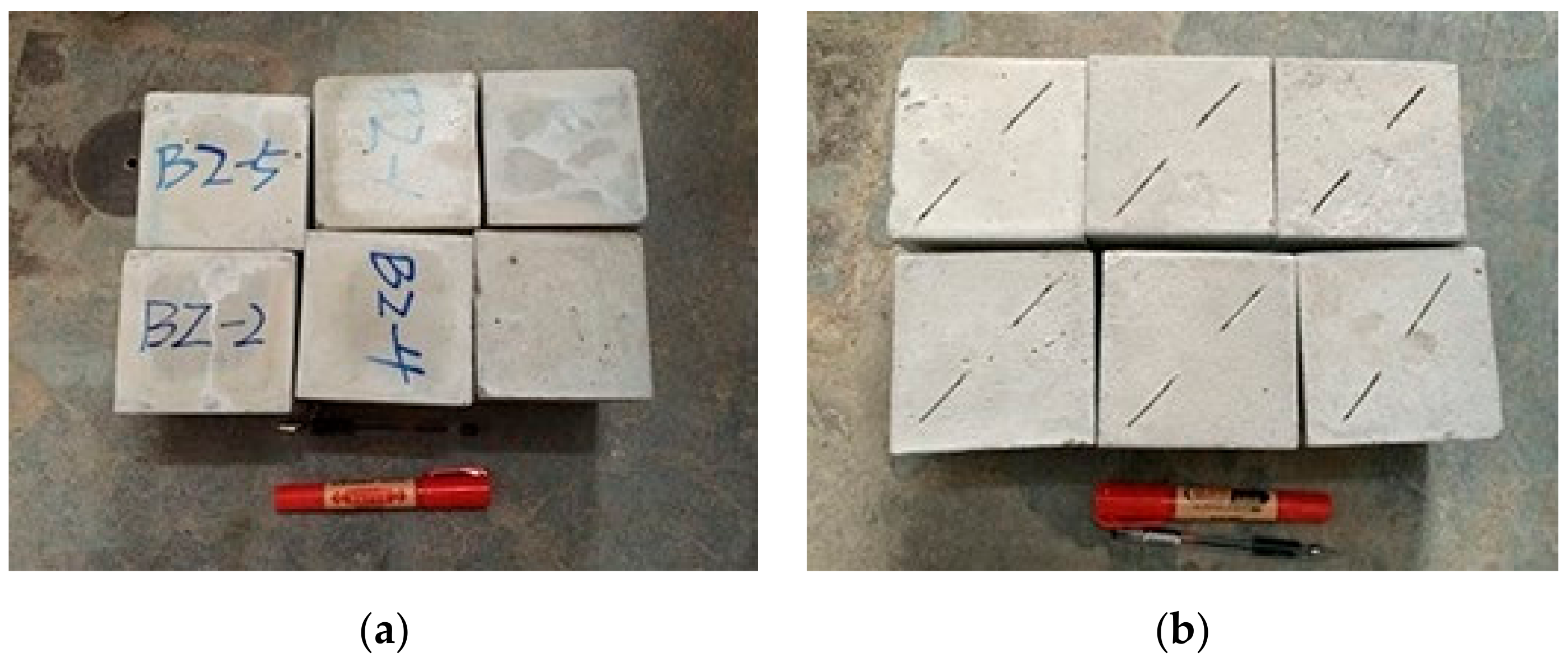

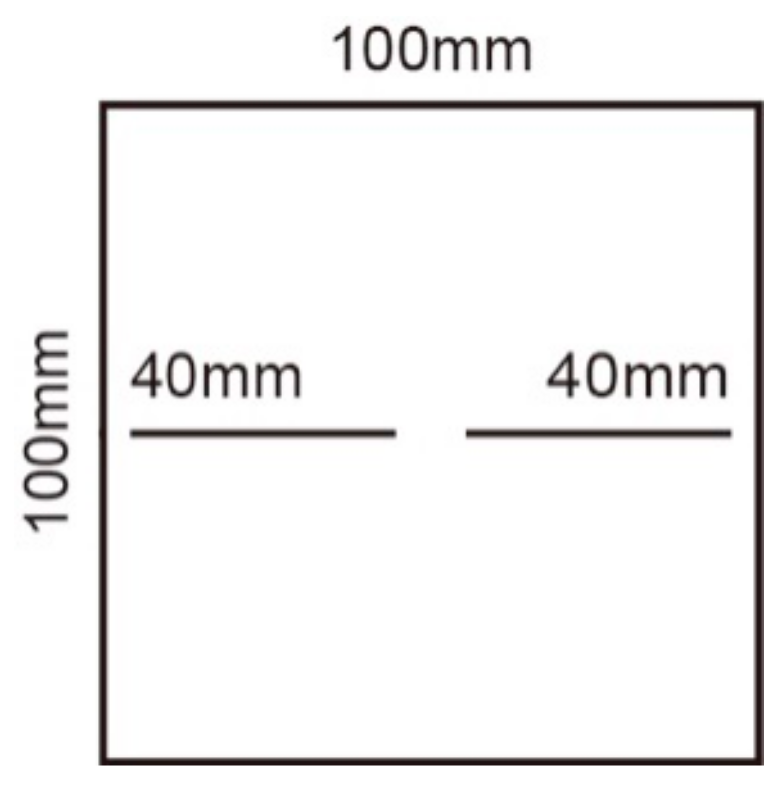


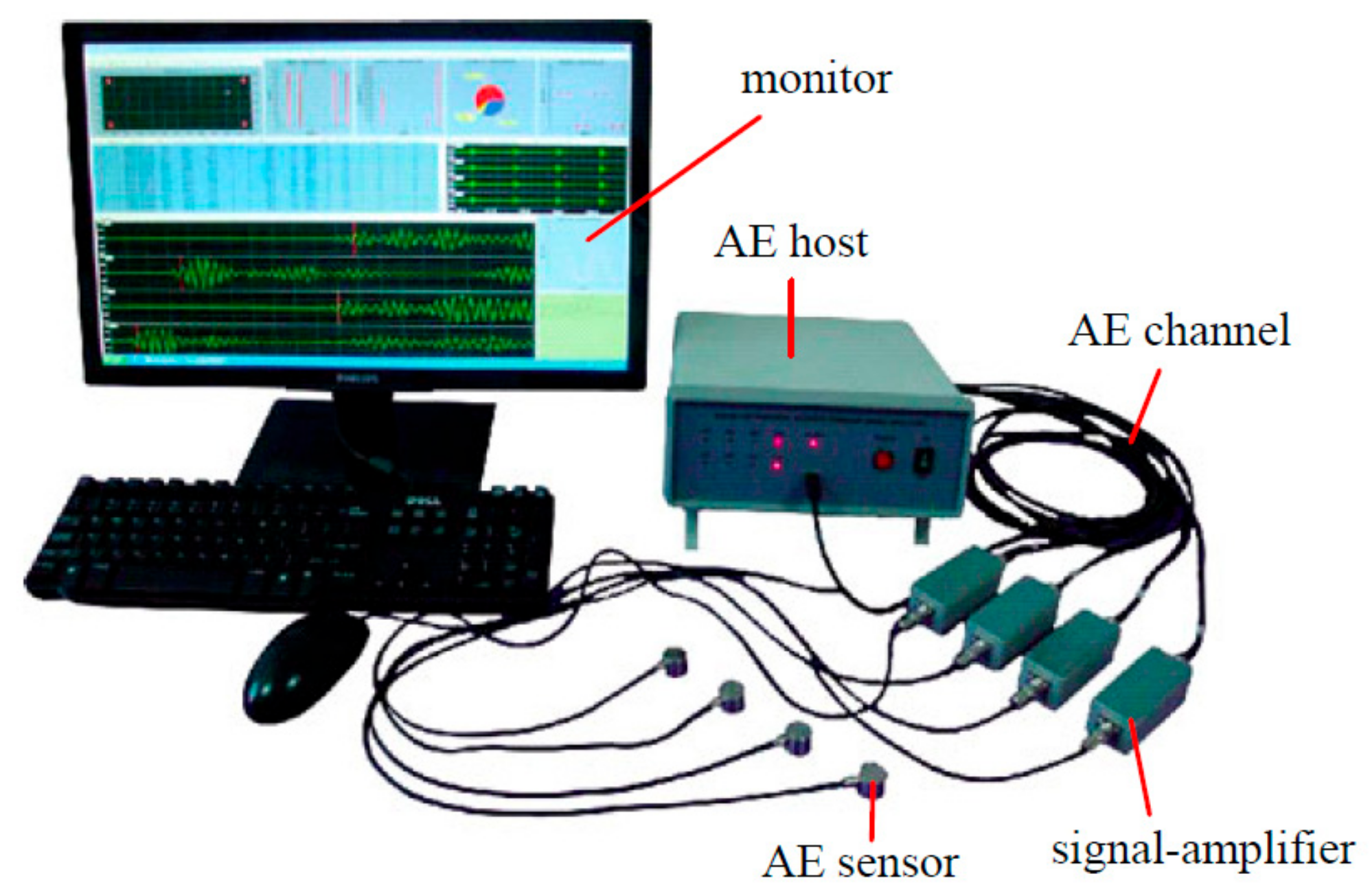
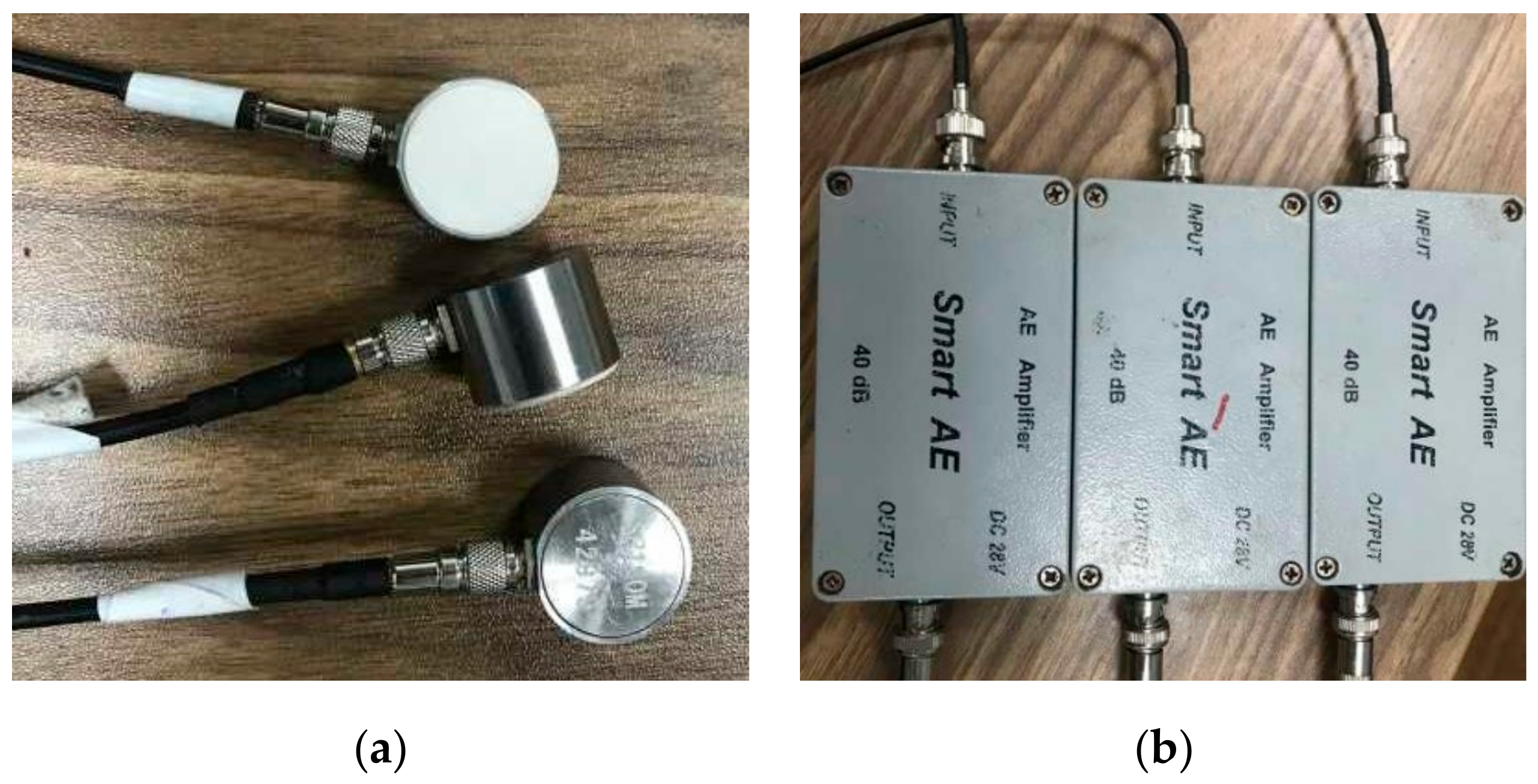
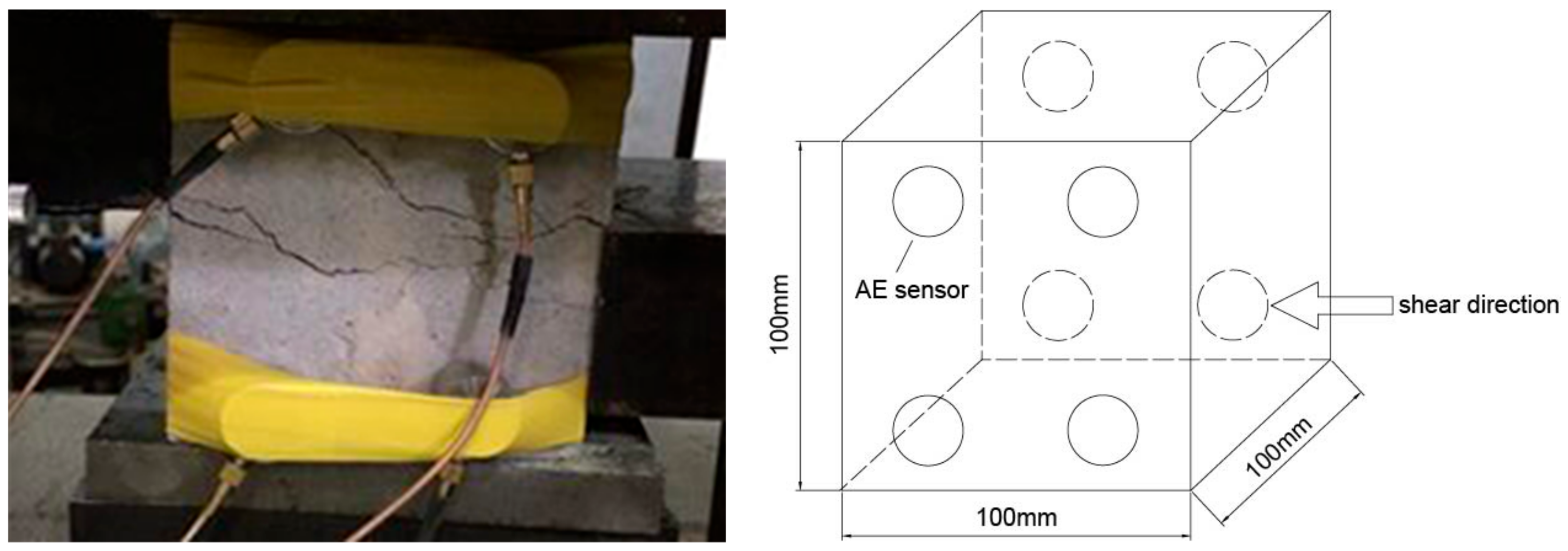

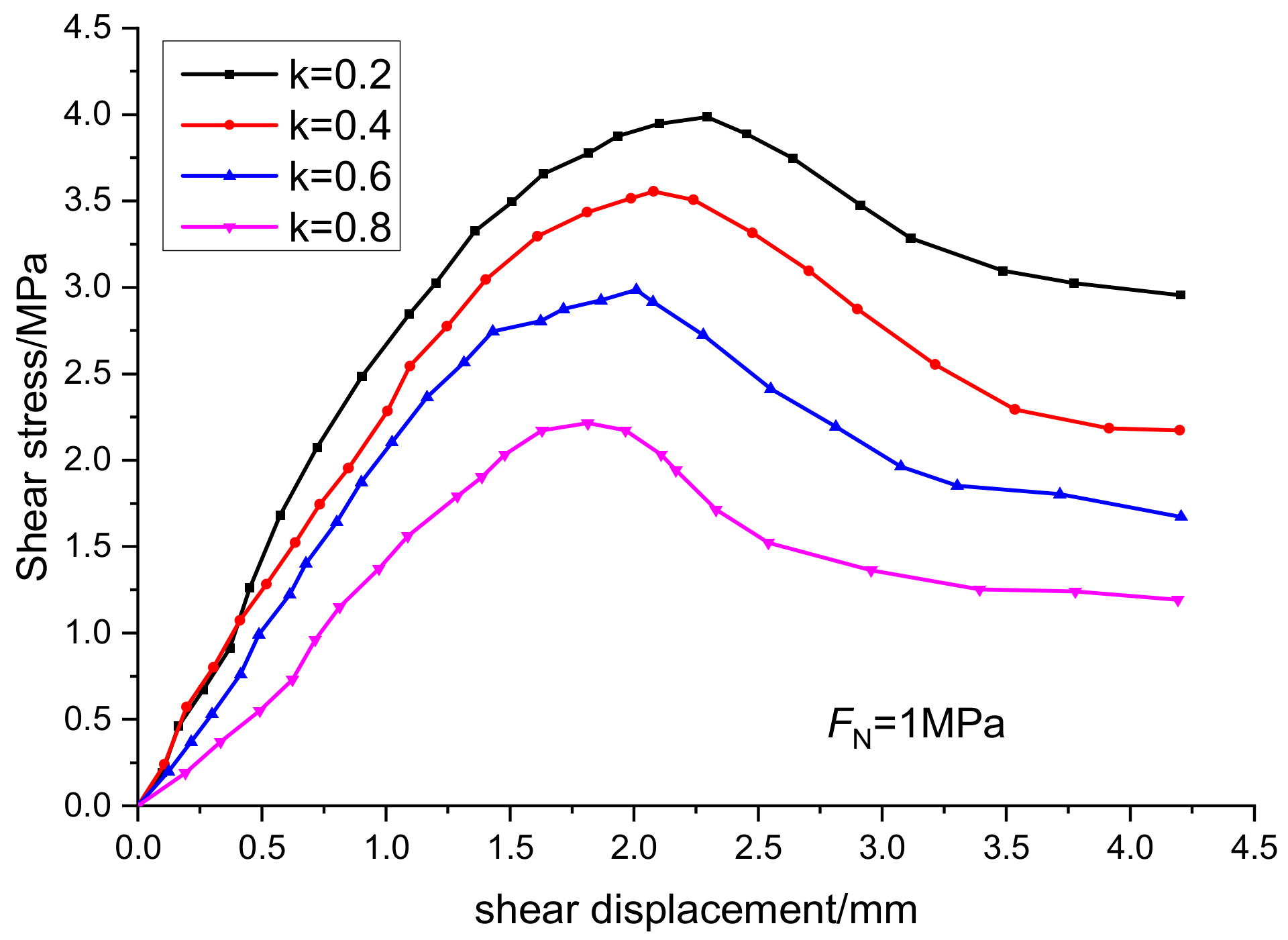
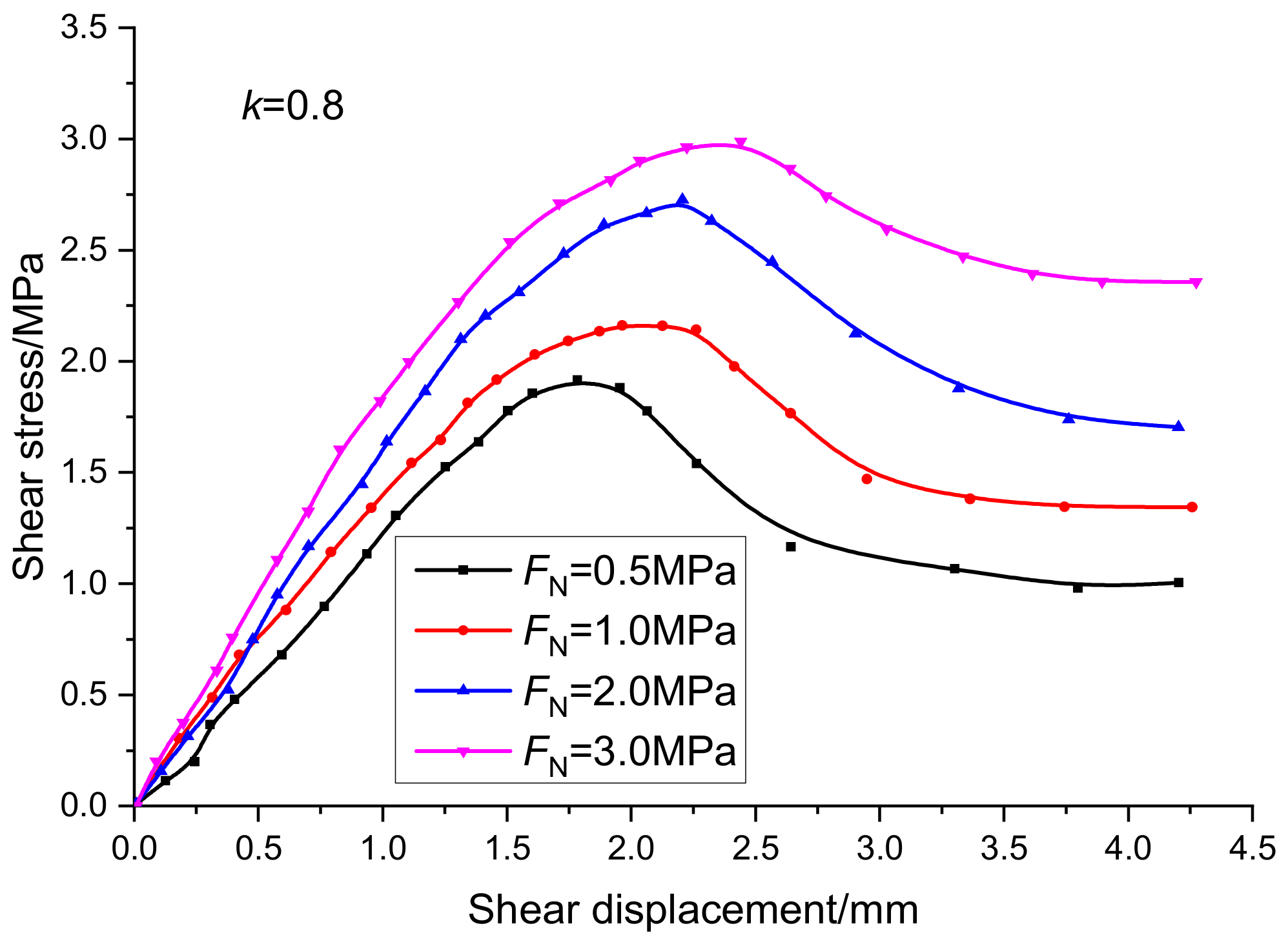
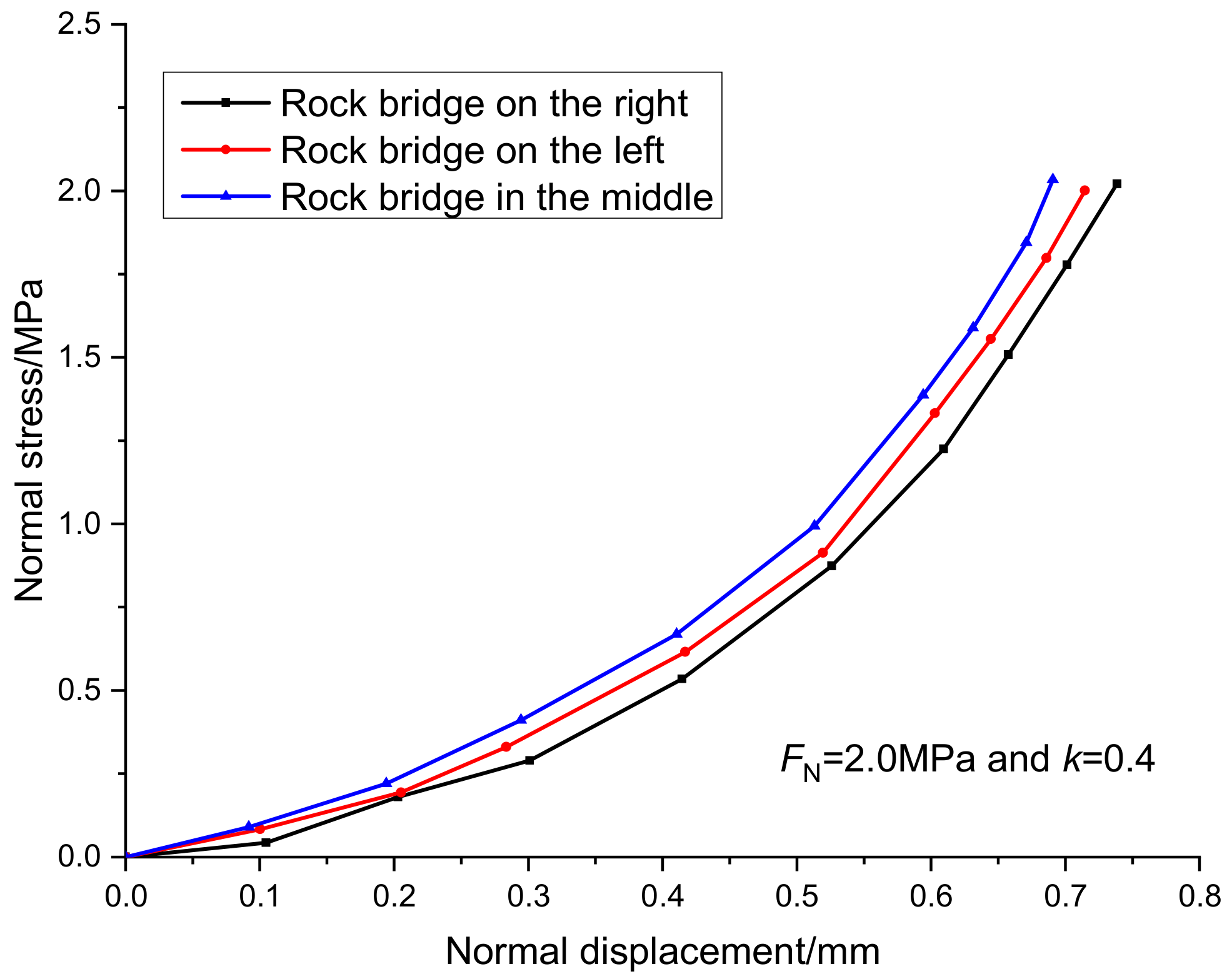
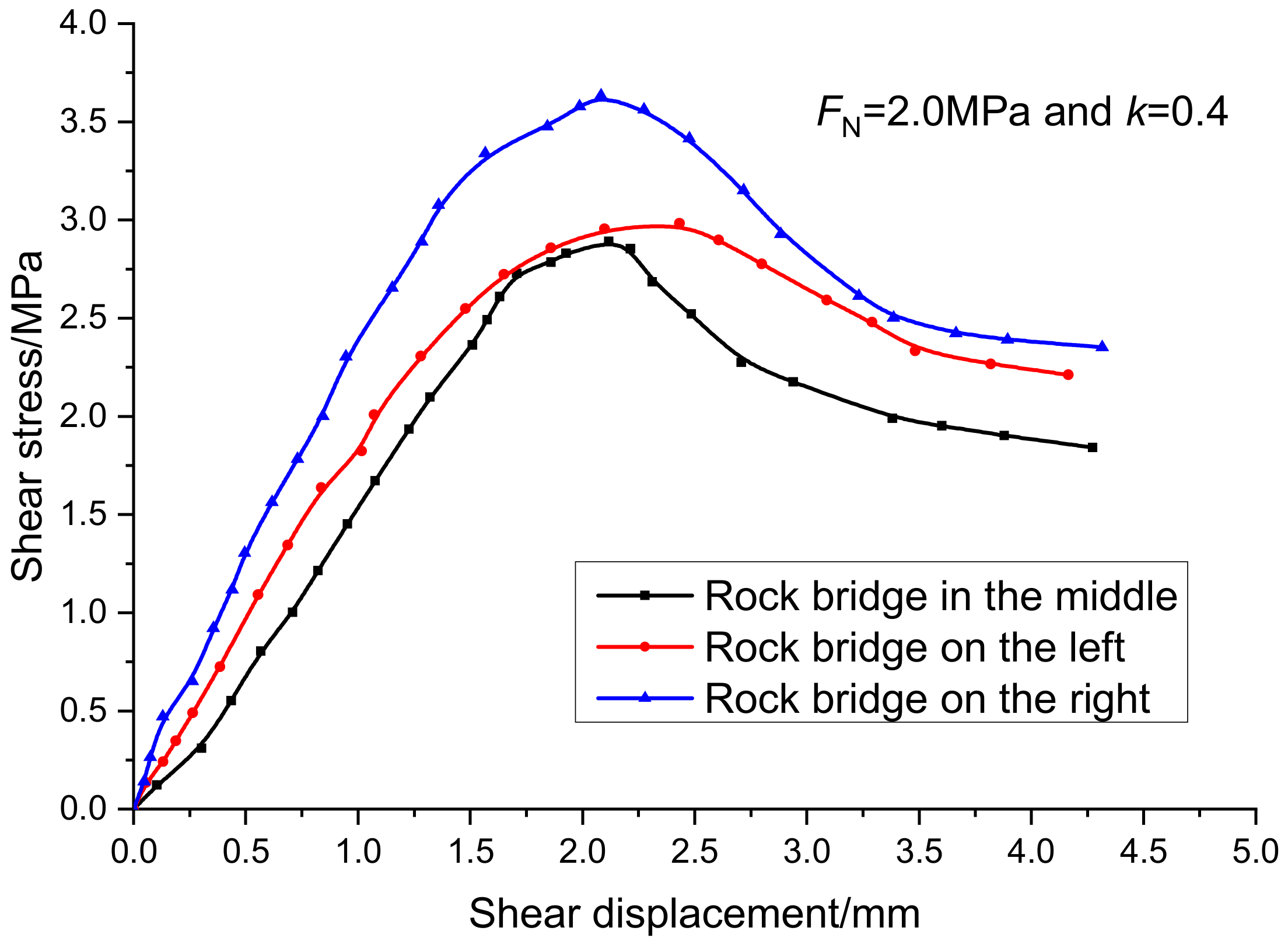

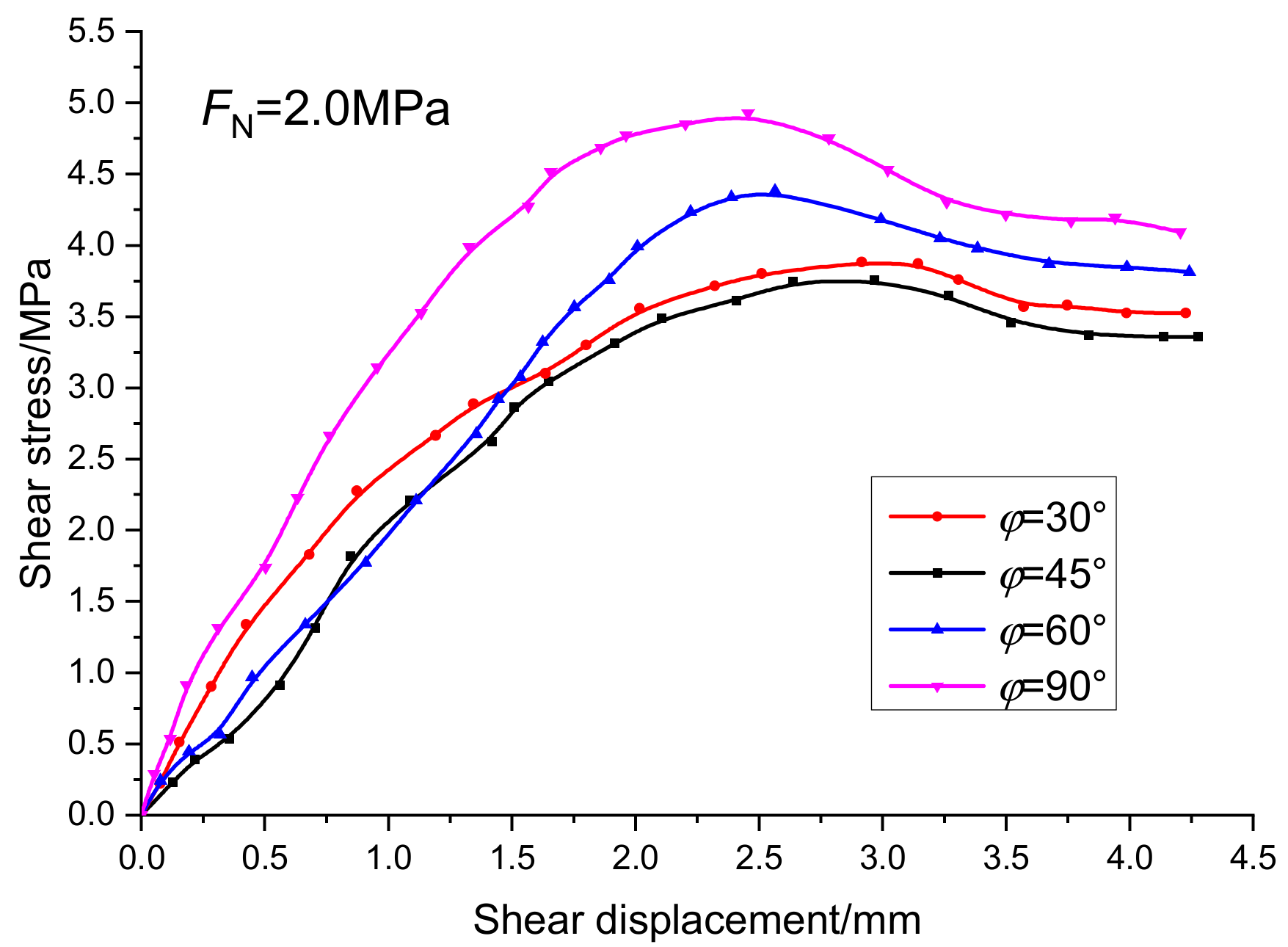

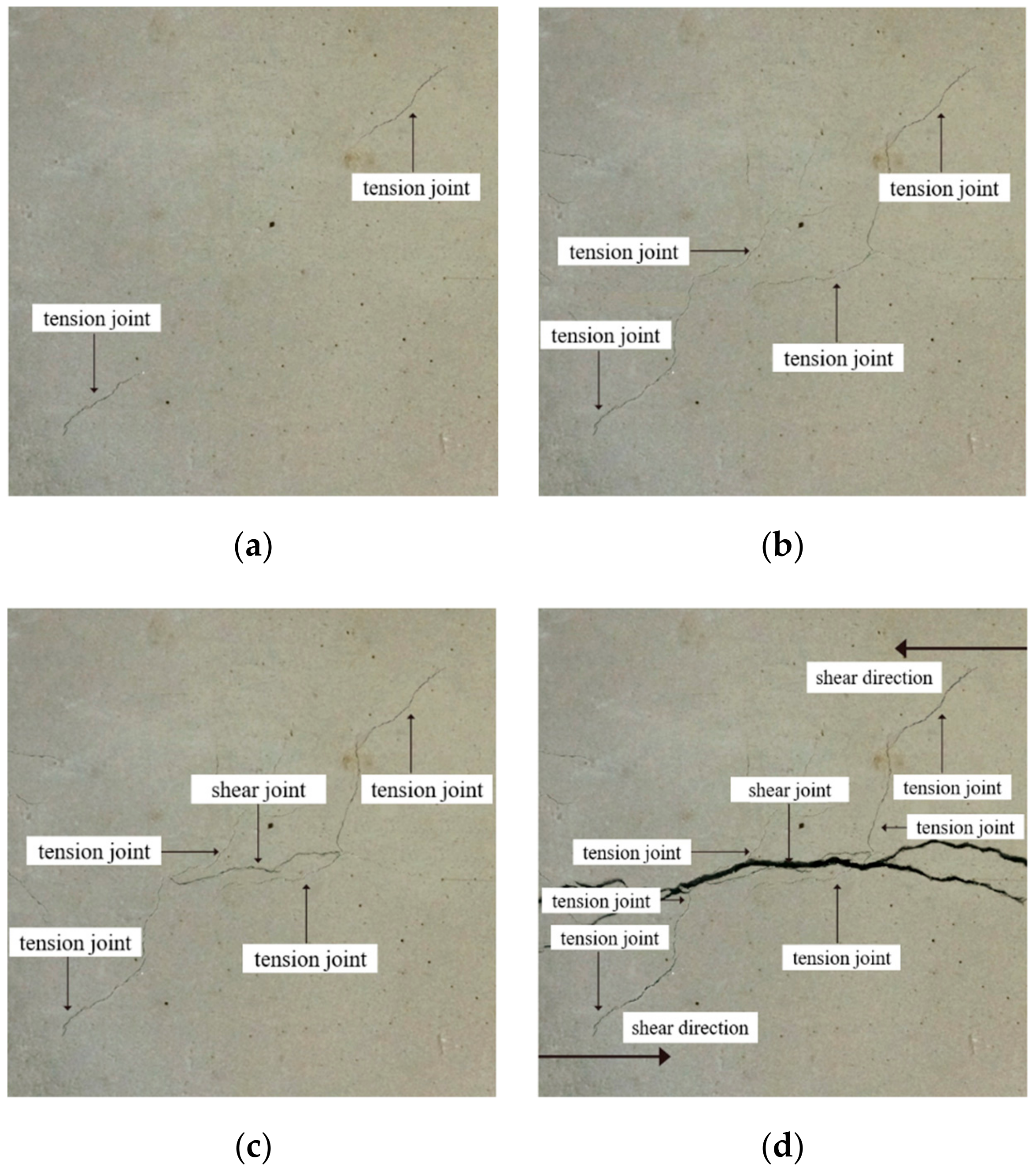
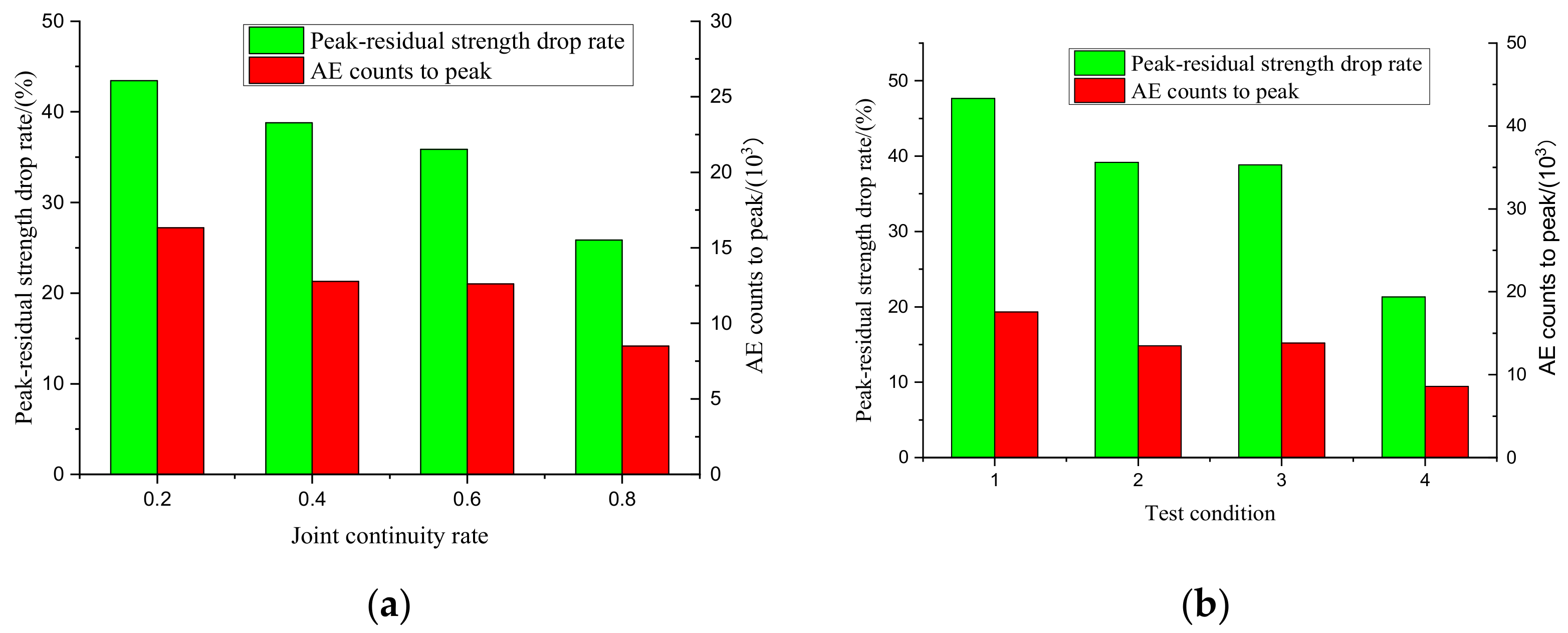
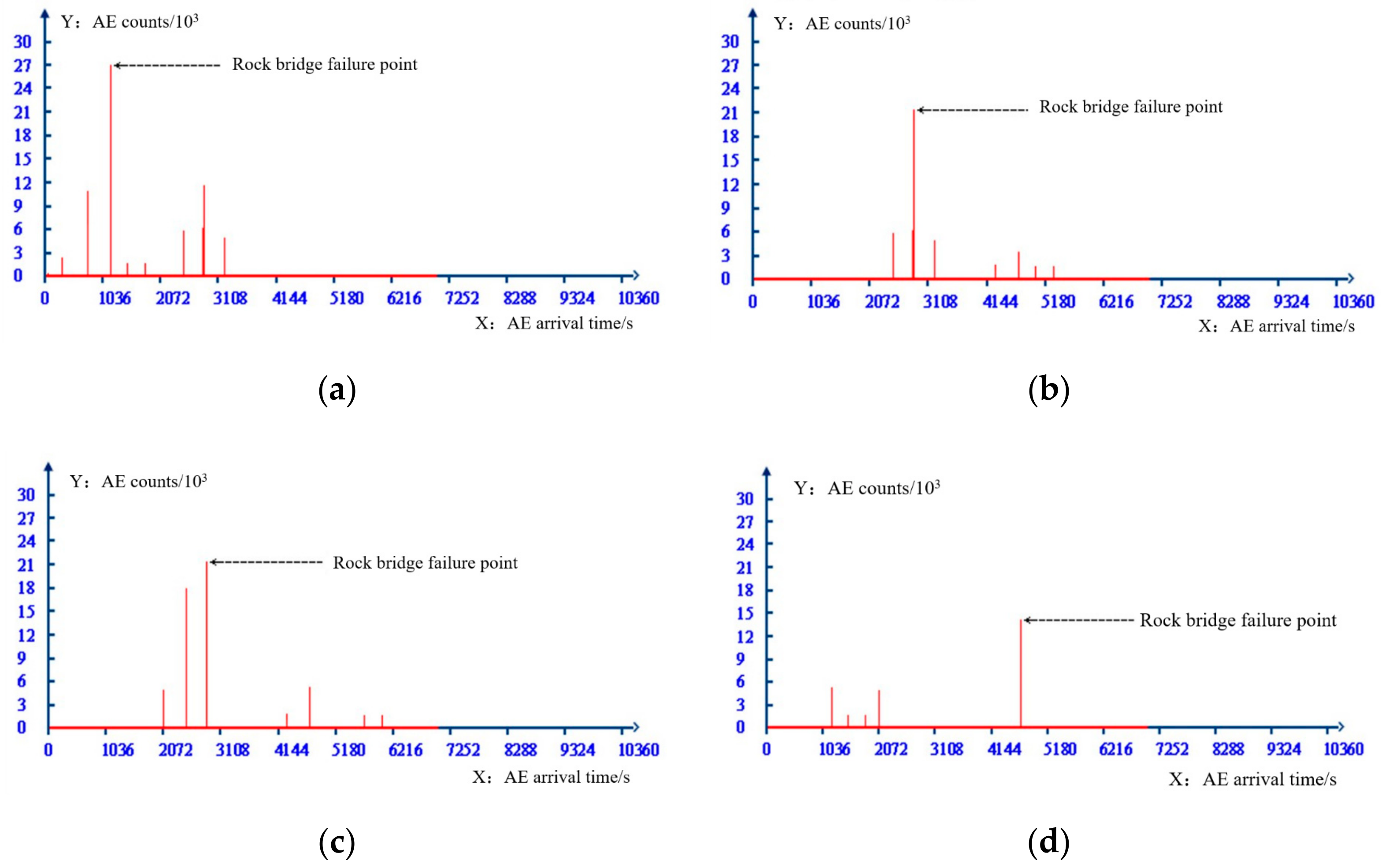

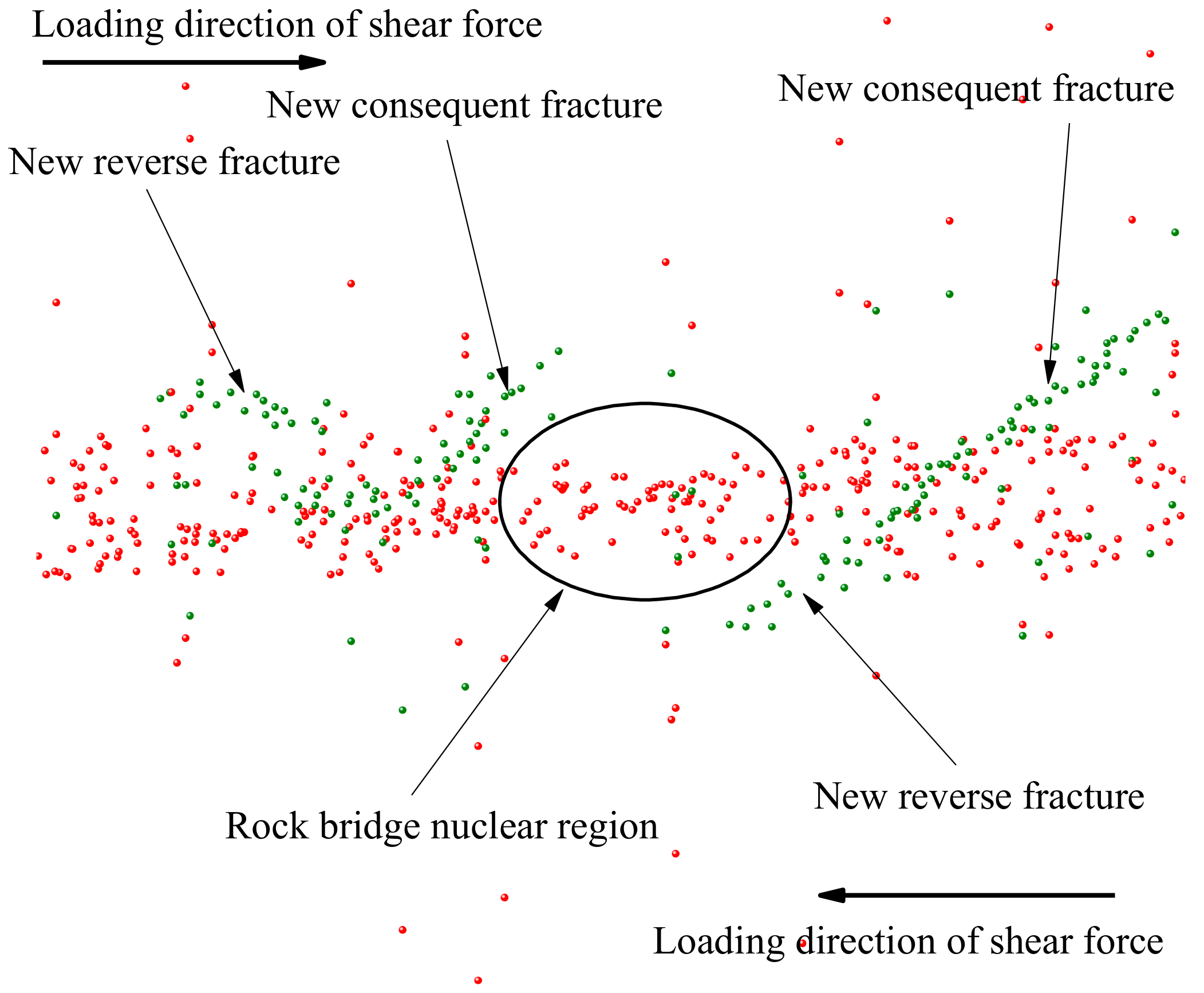
| Bulk Density/(kN/m3) | Uniaxial Strength/MPa | Elastic Modulus/GPa | Poisson’s Ratio | Tensile Strength/MPa | Cohesion/MPa | Internal Friction Angle/° |
|---|---|---|---|---|---|---|
| 19.7 | 26 | 2.7 | 0.2 | 2.6 | 3.90 | 42.1 |
| Joint Continuity Rate | Peak Strength/MPa | Residual Strength/MPa | Peak-Residual Strength Drop Rate/% | AE Counts to Peak/103 |
|---|---|---|---|---|
| 0.8 | 2.21 | 1.25 | 43.44 | 27.21 |
| 0.6 | 2.99 | 1.83 | 38.80 | 21.30 |
| 0.4 | 3.54 | 2.27 | 35.88 | 21.01 |
| 0.2 | 4.02 | 2.98 | 25.87 | 14.15 |
| Normal Stress/MPa | Peak Strength/MPa | Residual Strength/MPa | Peak-Residual Strength Drop Rate/% | AE Counts to Peak/103 |
|---|---|---|---|---|
| 0.5 | 1.91 | 1.00 | 47.64 | 19.32 |
| 1 | 2.17 | 1.32 | 39.17 | 14.83 |
| 2 | 2.73 | 1.67 | 38.83 | 15.21 |
| 3 | 3.00 | 2.36 | 21.33 | 9.45 |
© 2020 by the authors. Licensee MDPI, Basel, Switzerland. This article is an open access article distributed under the terms and conditions of the Creative Commons Attribution (CC BY) license (http://creativecommons.org/licenses/by/4.0/).
Share and Cite
Guo, Q.; Pan, J.; Cai, M.; Zhang, Y. Investigating the Effect of Rock Bridge on the Stability of Locked Section Slopes by the Direct Shear Test and Acoustic Emission Technique. Sensors 2020, 20, 638. https://doi.org/10.3390/s20030638
Guo Q, Pan J, Cai M, Zhang Y. Investigating the Effect of Rock Bridge on the Stability of Locked Section Slopes by the Direct Shear Test and Acoustic Emission Technique. Sensors. 2020; 20(3):638. https://doi.org/10.3390/s20030638
Chicago/Turabian StyleGuo, Qifeng, Jiliang Pan, Meifeng Cai, and Ying Zhang. 2020. "Investigating the Effect of Rock Bridge on the Stability of Locked Section Slopes by the Direct Shear Test and Acoustic Emission Technique" Sensors 20, no. 3: 638. https://doi.org/10.3390/s20030638





